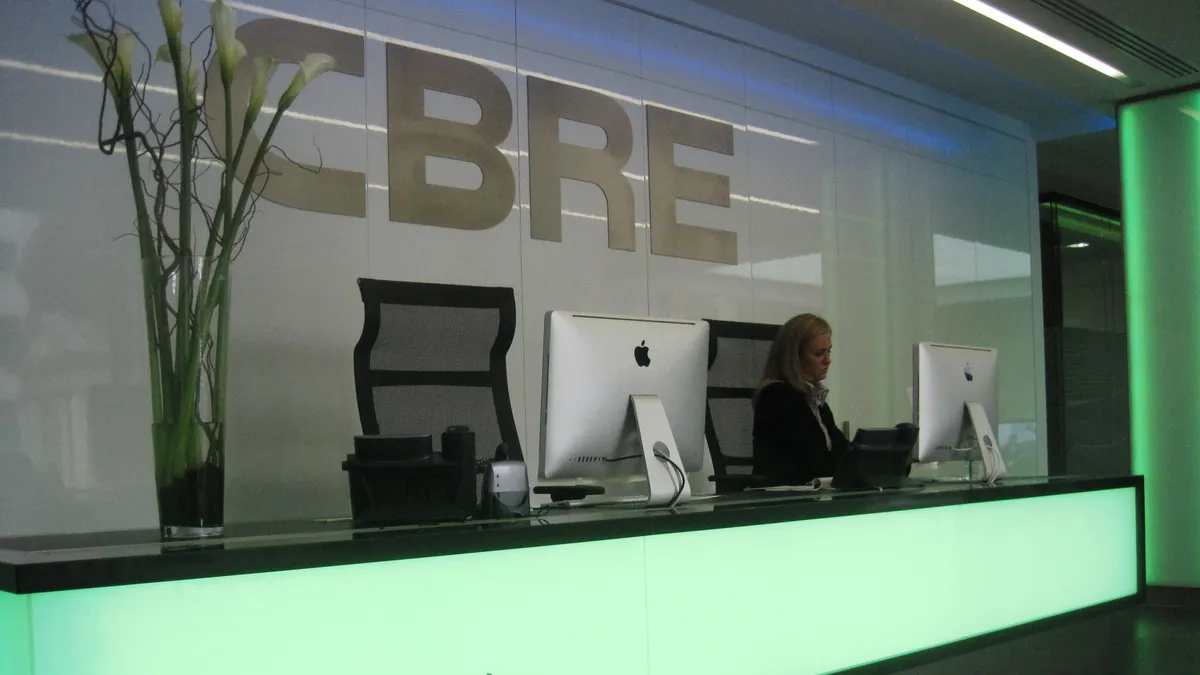Dive Brief:
- CBRE reported significant strides in the final quarter of 2023, including a 14% quarterly increase in facilities management revenue and a 13% rise for the year, according to a Thursday earnings call.
- The firm attributed the facilities management revenue growth to increased activity in the technology and financial services sectors within its enterprise business and robust growth of its U.S. local business. Operating profit for the overall Global Workplace Solutions segment increased 12.9% year over year, with project management revenue growing 11% in the fourth quarter and 14% for the year, led by its Turner & Townsend business.
- “Most significantly, our sizable GWS local business has been increasing net revenue at or above a mid-teens clip, and is well positioned to sustain this growth rate for the long term,” CBRE CEO Bob Sulentic said on the earnings call. “Notably, we had record pipeline conversion to new GWS contracts during Q4 with a balanced mix of new clients and existing client expansions.”
Dive Insight:
CBRE ended the 2023 fiscal year with year-over-year operating profit growth across all three of its business segments, marking the third highest full-year earnings in its history, Sulentic said in Thursday’s earnings report.
Against the backdrop of tight market conditions, CBRE and its competitors JLL and Cushman & Wakefield had posted year-over-year declines in leasing revenue in the third quarter of 2023. Despite a difficult year for commercial real estate, CBRE’s resilient businesses have continued to show strong growth, partially offsetting market-driven revenue declines in its businesses that are sensitive to interest rates and debt availability, Sulentic said on the call.
Those resilient businesses include GWS, loan servicing, valuation, recurring asset management fees from its investment management business and property management, which in aggregate generated nearly $1.6 billion in segment operating profit in 2023 and are expected to generate $1.8 billion in segment operating profits in 2024. This would represent a six-fold increase from 2011, CBRE Chief Financial Officer Emma Giamartino said on the call,
Technology, media and telecommunications clients accounted for 25% of the company’s Q4 facilities management revenue, with financial services and life sciences and healthcare industries each representing 20%. Seventeen percent of fourth quarter facilities management revenue came from the industrial and manufacturing clients, according to CBRE’s earnings presentation, while retail clients contributed 7%.
Sulentic noted that the acquisition of J&J Worldwide Services in early February will increase CBRE’s technical services capabilities for U.S. federal government clients, calling it a “mostly untapped channel in a difficult-to-penetrate market” that is characterized by steady growth and long-term contracts. CBRE stated the acquisition will provide an estimated $65 million in earnings before interest, tax, depreciation and amortization, with three quarters of that EBITDA expected to come in the 2024 fiscal year, Giamartino said on the call.
Sulentic also highlighted that CBRE’s recently formed strategic partnership to provide property management services for Brookfield Properties is one of the largest in the history of the sector, spanning 65 million square feet of U.S. office space.
As it relates to non-resilient businesses, CBRE’s Americas leasing revenue was flat year over year, with large office deals in Canada offsetting “modestly lower U.S. activity,” according to the company’s earnings release. Sales revenue in the Americas fell 22%, with declines less pronounced in industrial and retail than in multifamily and office markets, CBRE reported.
“We expect leasing to grow modestly in 2024. We are cautiously optimistic that the worst is over for office leasing, particularly for Class A properties, where we generate approximately two-thirds of leasing revenue,” Giamartino said on the call, noting that leading indicators from its data partner VTS point to U.S. office demand gradually turning up over the last six months.
“The growing consensus about an economic soft landing coupled with the apparent stabilization of office utilization rates may make more employers confident enough to commit to office leases,” Giamartino said.














